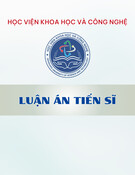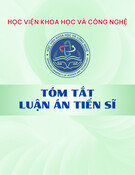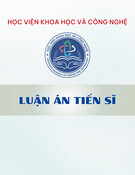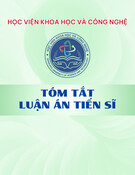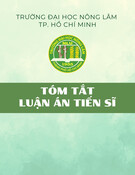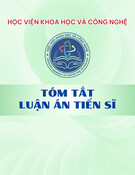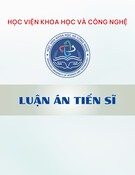
1
INTRODUCTION
1. Necessity of the study
Soybean or soya bean [Glycine max (L.) Merrill] belongs to the legume family
(Fabaceae), order Fabales. Soybean is one of the important crops of high economic
value with multiple uses, providing human feed, being a source of raw materials for
livestock, food industry, medicibe, cosmetics. In Vietnam, soybean is a long-standing
crop, having an important position in agricultural production and considered as a high
economic efficiency crop in the strategy of crop restructure, increasing the value of
agricultural products. With short growth duration, soybean can be cultivated in many
crop seasons during the year, being ideal in crop rotation, intercropping, increasing
of crop seasons and overlapping crop. Soybean production helps to increase land use
coefficient, create jobs and increase income for farmers.
The soybean planting area in Winter - Spring 2019 of Hanoi reached 2.9
thousand hectares over 3.4 thousand hectares planted for the whole year
(accounting for 85.3%); the yield was 1.69 tons/ha, the output reached 4.9
thousand tons out of 5.92 thousand tons/year (accounting for 83.05%). Soybean
has become the main crop, occupying an important position in the Winter crop
structure of Hanoi as well as the Red River Delta provinces.
However, the soybean production in Hanoi is still fragmented, dispersed, low
intensive investment, the application of new techniques is limited, and the
soybean production area is unstable and gradually shrinking. One of the main
reasons for low yield of soybeans is lack of collections of soybean varieties
suitable for the ecological conditions of Hanoi, as well as the appropriate and
synchronized technical measures.
Specifically, it usually rains around the end of September, at the beginning of
Winter soybean crop in Hanoi. The rain is prolonged and sometime heavy when
sowing soybean, the soil is always wet, the field can be flooded. Previously
selected soybean varieties were mostly drought and cold tolerant varieties;
research on flood-tolerant varieties has not been focused. Therefore, the selection
of soybean varieties that can be tolerant to waterlogging and adapted to the natural
conditions of Hanoi as well as identifying technical measures for Winter
soybeans soybeans on wet soil after rice harvesting to improve the yield and
efficiency of soybean production is necessary.
Based on the above mentioned necessity, we conducted the thesis: "Study on
selection and technical measures to improve waterlogging ability for Winter
soybean in Hanoi". The study on identification of soybean varieties tolerant to
waterlogging with farming conditions in Hanoi along with other technical
measures will contribute to improving the yield and output of soybeans in Hanoi,
and to raising incomes for farmers.
2. Objectives of the study
- Identifying soybean lines and varieties tolerant to waterlogging for the









